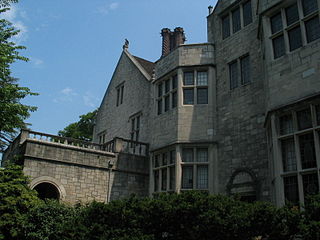
A shrub or bush is a small-to-medium-sized perennial woody plant. Unlike herbaceous plants, shrubs have persistent woody stems above the ground. Shrubs can be either deciduous or evergreen. They are distinguished from trees by their multiple stems and shorter height, less than 6–10 m (20–33 ft) tall. Small shrubs, less than 2 m (6.6 ft) tall are sometimes termed as subshrubs. Many botanical groups have species that are shrubs, and others that are trees and herbaceous plants instead.

An arboretum is a botanical collection composed exclusively of trees of a variety of species. Originally mostly created as a section in a larger garden or park for specimens of mostly non-local species, many modern arboreta are in botanical gardens as living collections of woody plants and is intended at least in part for scientific study.

A parterre is a part of a formal garden constructed on a level substrate, consisting of symmetrical patterns, made up by plant beds, plats, low hedges or coloured gravels, which are separated and connected by paths. Typically it was the part of the garden nearest the house, perhaps after a terrace. The view of a parterre from inside the house, especially from the upper floors, was a major consideration in its design. The word "parterre" was and is used both for the whole part of the garden containing parterres and for each individual section between the "alleys".

William Robinson: was an Irish practical gardener and journalist whose ideas about wild gardening spurred the movement that led to the popularising of the English cottage garden, a parallel to the search for honest simplicity and vernacular style of the British Arts and Crafts movement, and were important in promoting the woodland garden. Robinson is credited as an early practitioner of the mixed herbaceous border of hardy perennial plants, a champion too of the "wild garden", who vanquished the high Victorian pattern garden of planted-out bedding schemes. Robinson's new approach to gardening gained popularity through his magazines and several books—particularly The Wild Garden, illustrated by Alfred Parsons, and The English Flower Garden.
Garden design is the art and process of designing and creating plans for layout and planting of gardens and landscapes. Garden design may be done by the garden owner themselves, or by professionals of varying levels of experience and expertise. Most professional garden designers have some training in horticulture and the principles of design. Some are also landscape architects, a more formal level of training that usually requires an advanced degree and often a state license. Amateur gardeners may also attain a high level of experience from extensive hours working in their own gardens, through casual study, serious study in Master gardener programs, or by joining gardening clubs.

Coastal Maine Botanical Gardens is a botanical garden in Boothbay, Maine. It was opened in 2007.
University of Nevada, Reno Arboretum is a state arboretum located across the campus at the University of Nevada, Reno in Reno, Nevada.

The cottage garden is a distinct style that uses informal design, traditional materials, dense plantings, and a mixture of ornamental and edible plants. English in origin, it depends on grace and charm rather than grandeur and formal structure. Homely and functional gardens connected to cottages go back centuries, but their stylized reinvention occurred in 1870s England, as a reaction to the more structured, rigorously maintained estate gardens with their formal designs and mass plantings of greenhouse annuals.

The English landscape garden, also called English landscape park or simply the English garden, is a style of "landscape" garden which emerged in England in the early 18th century, and spread across Europe, replacing the more formal, symmetrical French formal garden which had emerged in the 17th century as the principal gardening style of Europe. The English garden presented an idealized view of nature. Created and pioneered by William Kent and others, the "informal" garden style originated as a revolt against the architectural garden and drew inspiration from paintings of landscapes by Salvator Rosa, Claude Lorrain, and Nicolas Poussin.

Bowen Park is a heritage-listed park of 17,740 square metres (191,000 sq ft) at O'Connell Terrace, Bowen Hills, City of Brisbane, Queensland, Australia. It was built from 1863 to 1950s. It was also known as the Acclimatisation Society Gardens. It was added to the Queensland Heritage Register on 26 February 1999.

Planting Fields Arboretum State Historic Park, which includes the Coe Hall Historic House Museum, is an arboretum and state park covering over 400 acres (160 ha) located in the village of Upper Brookville in the town of Oyster Bay, New York.

Hamilton Gardens is a public garden park in the south of Hamilton owned and managed by Hamilton City Council in New Zealand. The 54-hectare park is based on the banks of the Waikato River and includes enclosed gardens, open lawns, a lake, a nursery, a convention centre and the Hamilton East Cemetery. It is the Waikato region's most popular visitor attraction, attracting more than 1 million people and hosting more than 2,000 events a year.

Luscombe Castle is a country house situated near the resort town of Dawlish, in the county of Devon in England. Upon purchasing the land at Luscombe in 1797, Charles Hoare demolished the existing house and commissioned architects John Nash and Humphrey Repton to design a new house and gardens at the site. Nash and Repton came up with an asymmetrical designed building made from Portland stone, with castellated parapets, turrets and pinnacles to create the feel of a picturesque castle.

The Morris Arboretum & Gardens of the University of Pennsylvania is the official arboretum of the Commonwealth of Pennsylvania. The Arboretum is open daily except for major holidays. It is located at 100 East Northwestern Avenue, Chestnut Hill, Philadelphia, Pennsylvania.

The New York Chinese Scholar's Garden is part of the Staten Island Botanical Garden, located in the Snug Harbor Cultural Center. Materials were shipped to Staten Island in the spring of 1998, when a team of 40 Chinese artists and artisans from Suzhou constructed the garden. It opened in June of 1999.

In English gardening history, the pleasure ground or pleasure garden was the parts of a large garden designed for the use of the owners, as opposed to the kitchen garden and the wider park. It normally included flower gardens, typically directly outside the house, and areas of lawn, used for playing games, and perhaps "groves" or a wilderness for walking around. Smaller gardens were often or usually entirely arranged as pleasure grounds, as are modern public parks.

Paris today has more than 421 municipal parks and gardens, covering more than three thousand hectares and containing more than 250,000 trees. Two of Paris's oldest and most famous gardens are the Tuileries Garden, created in 1564 for the Tuileries Palace, and redone by André Le Nôtre in 1664; and the Luxembourg Garden, belonging to a château built for Marie de' Medici in 1612, which today houses the French Senate. The Jardin des Plantes was the first botanical garden in Paris, created in 1626 by Louis XIII's doctor Guy de La Brosse for the cultivation of medicinal plants. Between 1853 and 1870, the Emperor Napoleon III and the city's first director of parks and gardens, Jean-Charles Adolphe Alphand, created the Bois de Boulogne, the Bois de Vincennes, Parc Montsouris and the Parc des Buttes Chaumont, located at the four points of the compass around the city, as well as many smaller parks, squares and gardens in the neighborhoods of the city. One hundred sixty-six new parks have been created since 1977, most notably the Parc de la Villette (1987–1991) and Parc André Citroën (1992).

In the Western history of gardening, from the 16th to early 19th centuries, a wilderness was a highly artificial and formalized type of woodland, forming a section of a large garden. Though examples varied greatly, a typical English style was a number of geometrically-arranged compartments closed round by hedges, each compartment planted inside with relatively small trees. Between the compartments there were wide walkways or "alleys", usually of grass, sometimes of gravel. The wilderness provided shade in hot weather, and relative privacy. Though often said by garden writers at the time to be intended for meditation and reading, the wilderness was much used for walking, and often flirtation. There were few if any flowers, but there might be statues, and some seating, especially in garden rooms or salle vertes, clearings left empty. Some had other features, such as a garden maze.

A woodland garden is a garden or section of a garden that includes large trees and is laid out so as to appear as more or less natural woodland, though it is often actually an artificial creation. Typically it includes plantings of flowering shrubs and other garden plants, especially near the paths through it.





















